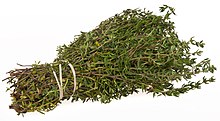Culinary herbs

Culinary herbs are distinguished from vegetables in that, like spices, they are used in small amounts and provide flavor rather than substance to food.
Herbs can be perennials such as thyme, sage or lavender, biennials such as parsley, or annuals like basil. Perennial herbs can be shrubs such as rosemary (Rosmarinus officinalis), or trees such as bay laurel (Laurus nobilis) – this contrasts with botanical herbs, which by definition cannot be woody plants. Some plants are used as both herbs and spices, such as dill weed and dill seed or coriander leaves and seeds. There are also some herbs, such as those in the mint family, that are used for both culinary and medicinal purposes.
Emperor Charlemagne (742–814) compiled a list of 74 different herbs that were to be planted in his gardens. The connection between herbs and health is important already in the European Middle Ages--The Forme of Cury (that is, "cookery") promotes extensive use of herbs, including in salads, and claims in its preface "the assent and advisement of the masters of physic and philosophy in the King's Court".
Comments
Post a Comment